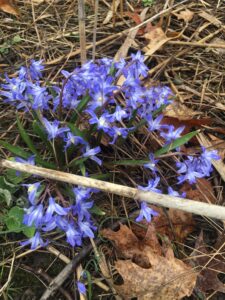At the Intersection of Public History and Public Health: My Pandemic Experience
By Amy Pepe, Visitor Services and Public Programs Manager at Rose Hill Mansion and Johnston House
I typically work from my home office on the grounds of Rose Hill Mansion, so the shift to work-from-home hasn’t been as abrupt for me as it has been for many of my co-workers. But, it is very quiet here. I began this job in April 2019, so I know that typically, even before the season is in full swing, Rose Hill is a very busy place. Normally the grounds and buildings would already be bustling with yard work, restocking the gift shop, volunteers and docents preparing for the season, and local 4th graders coming to participate in “Taking Tea.” I would be busy making docent schedules and coordinating group tours and events for the next 6 months. This year, however, the things that signal the start of our “busy” season are postponed or cancelled until it is safe again for us to gather in public places. Needless to say, this is not how I imagined the beginning of my second season at Rose Hill would go.

Spring has sprung at Rose Hill.
The history field as a whole is taking steps right now to create a record of this experience. It is important to document our pandemic experiences now, so that there is a diverse and reliable historical record for the future. Museums and historical societies (like us!) specifically have been getting very creative in offering virtual tours and digital activities to engage the public. These are wonderful tools that have emerged out of a difficult situation. Yet we are still faced with the question of what our in-person and face-to-face experiences look like once we reopen.
To be honest, I have never much considered what it means when public history meets public health. Having managed historical sites for a number of years, I am familiar with considering guest safety, comfort, and accessibility in the course of our work. But considering the impact of public health on the museum field is something I, and many of my colleagues, have never had to face. I find myself calculating the number of doorknobs in the mansion that would need to be disinfected in between every tour, how many guests we can accommodate while still maintaining social distance, and what cleaning supplies we will need to keep our employees and visitors healthy. Public health will have to be a new priority for the museum field as we emerge from this pandemic. We now know that the operation of our historic sites is linked to public health, an important lesson. We may not be trying to get back to normal as much as we adapt to a new normal. In the meantime, I’m glad we have so many resources at our fingertips that allow us to engage with our audiences and colleagues remotely.

My co-workers, sunbathing.
On a more personal level, I’m enjoying the company of my furrier co-workers (my dog, Quinn and cat, Penny). They hang out every morning on the floor of my office as that gets the best sunshine. Via Zoom, I’ve connected with my far-flung extended family from coast to coast, hearing about everyone’s pandemic experiences across 7 states and 3 time zones. This is definitely a silver lining; when else would all 20+ of us have been home and available at the same time? Grocery shopping has become the highlight of my week (I get to leave the house!), but also a sobering reminder of the situation at hand.
As I write this, it is May 1, the day we should have opened Rose Hill for the season. I look forward to the day we can all safely gather again in our favorite places.
What might future historians and generations need to understand the COVID-19 Pandemic? All of us have a story to tell on how the pandemic is affecting our lives. Are you in an at-risk group or have someone in your home who is? How has the stay-at-home order affected you? Do you shop less or use a grocery delivery service? For students at home, what has your experience been like? What is your new normal? Join the Geneva Historical Society in documenting this historic moment through “We Stay At Home: A Record of Geneva During the 2020 Pandemic.” Share your story through narratives (a letter, poem, song, recipes, and short story), images (photographs, screenshots of social media, memes), audio, videos, and files (emails, flyers, announcement, text messages, tweets). To share your story, go to https://historicgeneva.org/programs-and-exhibits/we-stayed-at-home/.
